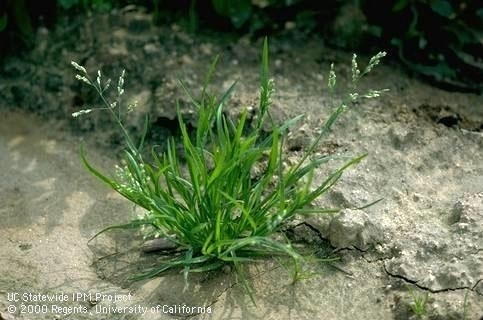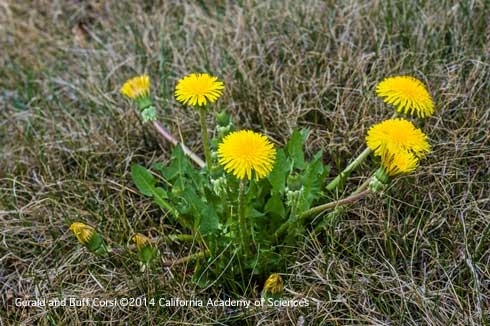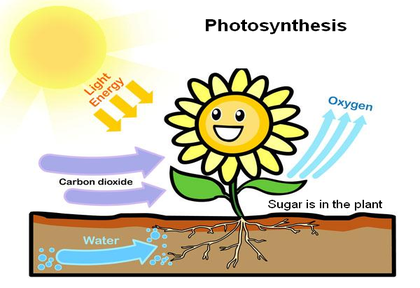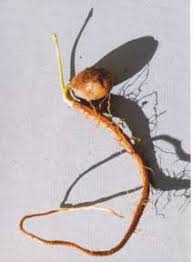By Penny Pawl, UC Master Gardener of Napa County
As my garden helper and I pull weeds this spring—and there are so many—I look at the different roots of the various weeds. Some come out of the ground with feathery thin roots (known as fibrous roots) and others, which seem almost impossible to pull even in damp soil, have a long taproot. Just what are roots for, other than to anchor the plant to the soil?
Without roots, plants would be much like tumbleweeds blowing around in the wind. But roots do so much more than hold the plant in place.
All the water and minerals needed for the top of the plant to grow must travel through the roots. The process of photosynthesis, whereby leaves gather energy from the sun, relies on the roots to absorb water and minerals from the soil and transfer them to the leaves. This process ensures that the plant stays healthy and continues to grow. Plants that don't get sufficient sunlight will often die from lack of photosynthesis.
When you look at a tree in the forest or garden, look at how far the branches reach from the trunk. In many cases, the roots extend beyond that space. In fact, redwood roots are very invasive and travel well beyond the limbs. They regularly come up in my vegetable garden beds.
A tree's root system is at least as deep as the tree is tall. One of the largest tree root systems is in the Lake Tahoe area. It is said that the quaking aspen trees that grow at high elevations are all on one root system. The trees have sprung up as the roots have moved through the area from adventitious buds on the parent root system. In one area in the high mountains, the aspens seem to go on for miles.
What is an adventitious bud? According to the dictionary, it is “a bud arising in other than the normal position (as where elongation has ceased) and lacking a vascular trace.”
A taproot is an extension of the trunk that goes down into the soil. It anchors a tall tree but also sends out fibrous roots seeking water and the minerals needed for growth.
The type of soil that roots are growing in has an impact on their growth. Hardpan will stop roots and make them grow sideways rather than down. Hardpan is caused by compaction of the soil, possibly from a layer of clay being laid down at some point and then covered with other soil, or from the compaction of large equipment running over the soil. This can often cause the plant to fail to receive the water and nutrients needed to grow or even stay alive. At that point, the plant may die.
When you are working in your vegetable garden, remember that the roots need room to grow. Tomatoes are one of the deepest-rooted vegetables and need a lot of space to expand. What you see on top may be doubled under the soil.
With some vegetables, we eat the root instead of, or in addition to, the tops. Carrots, potatoes and beets are all examples of edible roots. Carrots tops are smaller than the tasty taproot.
For several years, I have enjoyed a wonderful book called Roots Demystified by the Santa Rosa garden writer Robert Kourik. The book includes illustrations showing the extent of the root systems of many different plants. Kourik writes that the root is what first appears when a seed sprouts.
I happened across some acorns that birds or squirrels planted in a couple of my pots. The roots were about a foot long yet nothing had sprouted from the top. If left alone, the foliage would eventually sprout after the roots were quite grown out.
So remember to take care of those roots. Avoid walking over them to minimize soil compaction. And if your soil does become compacted, reach for the compost.
The UC Master Gardeners of Napa County are volunteers who provide University of California research-based information on home gardening. To find out more about home gardening or upcoming programs, visit the Master Gardener website (napamg.ucanr.edu). Our office is temporarily closed but we are answering questions remotely and by email. Send your gardening questions to mastergardeners@countyofnapa.org or leave a phone message at 707-253-4143 and a Master Gardener will respond shortly.
Attached Images:

Weed, annual bluegrass (UC ANR). This has fibrous roots.

Weed, dandelion (UC ANR from Calif Acad of Sciences). This has a taproot.

Photosynthesis (Teaching the Kid)

Development of tomato roots (CA.gov)

Roots we eat--carrots, potatoes, beets (MedicineNet)

That acorn root develops before the leaves appear.(UNH Extension-University of New Hampshire)